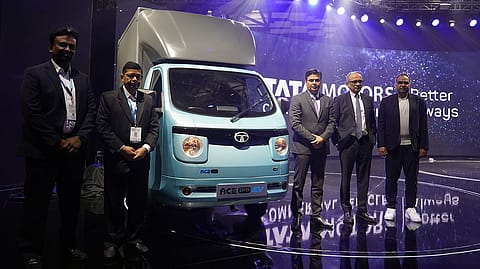Tata Motors expects growth in high single-digits in H2 FY26, buoyed by GST-fuelled demand
The maker of commercial vehicles expects demand to sustain in the latter half of the year, after the GST rate cut and the festive season boosted sentiment.

Tata Motors, the newly listed commercial vehicles arm of the Tata Group, expects high single-digit growth in the second half of FY26, buoyed by a resurgence in demand following the reduction in GST on commercial vehicles.
“The reduction in GST has benefited demand in two ways. Firstly, it has directly benefited B2C customers, who do not take input credit,” said Girish Wagh, MD and CEO, Tata Motors, at a post-earnings press conference. According to Wagh, B2C customers have driven demand for light commercial vehicles and the segments below it. “We also witnessed conversion of pent-up demand, after purchases were deferred in anticipation of reduced GST rates. Volumes have increased in September and October,” he added.
The second benefit, according to Wagh, has been an indirect benefit of the total cost of ownership of commercial vehicles—reducing by 1–1.5%—with GST rates on spare parts reduced. Moreover, as consumption increased, demand for freight and its utilisation also rose, driving demand for commercial vehicles.
Wagh has also identified tipper trucks as a segment where a spurt in demand has been witnessed, post the monsoon season. “At the end of August, the medium-to-heavy commercial vehicles (MHCV) saw some pressure. Since September, MHCV, especially heavy-duty trucks, has seen an uptick coming from mining and infrastructure projects for tippers. Even on cargo from good utilisation levels leading to an improved pipeline,” explained Wagh.
On the recently announced acquisition of Iveco, Wagh said that while the deal is currently in the due diligence stage—and is on track to be completed by April 2026—the combined topline of the two companies is expected to be $24 billion. “The two companies complement each other. We will look at each other’s products for different markets, share technologies, develop programmes of a similar nature from a capex perspective, and use design-to-value techniques to reduce material costs and operating expenses. Regulatory approvals are proceeding exceedingly well,” Wagh explained.
In its first results post-listing, Tata Motors posted a consolidated net loss of ₹867 crore in its second quarter, primarily due to higher material costs and a one-time fair-value loss on its investment in Tata Capital, amounting to ₹2,027 crore. It reported quarterly revenue from operations of ₹18,585 crore, an increase of 6% from the year-ago period.
The CV segment recorded wholesales of about 96,800 units, an increase of 12%. Domestic volumes were up 9% year-on-year, while exports were up 75%. Its domestic CV VAHAN market share was steady at 35.3% in the first half of FY26.
